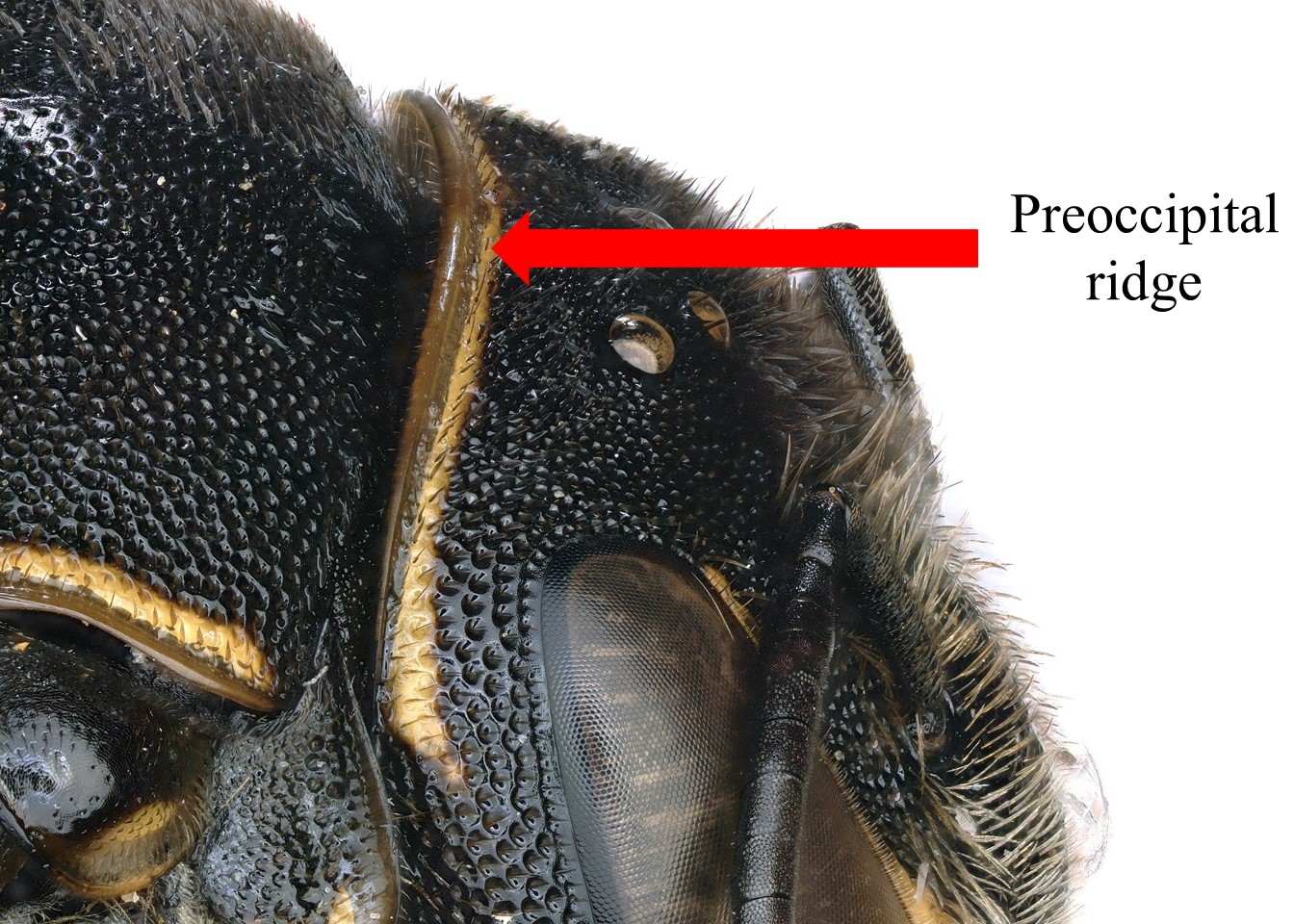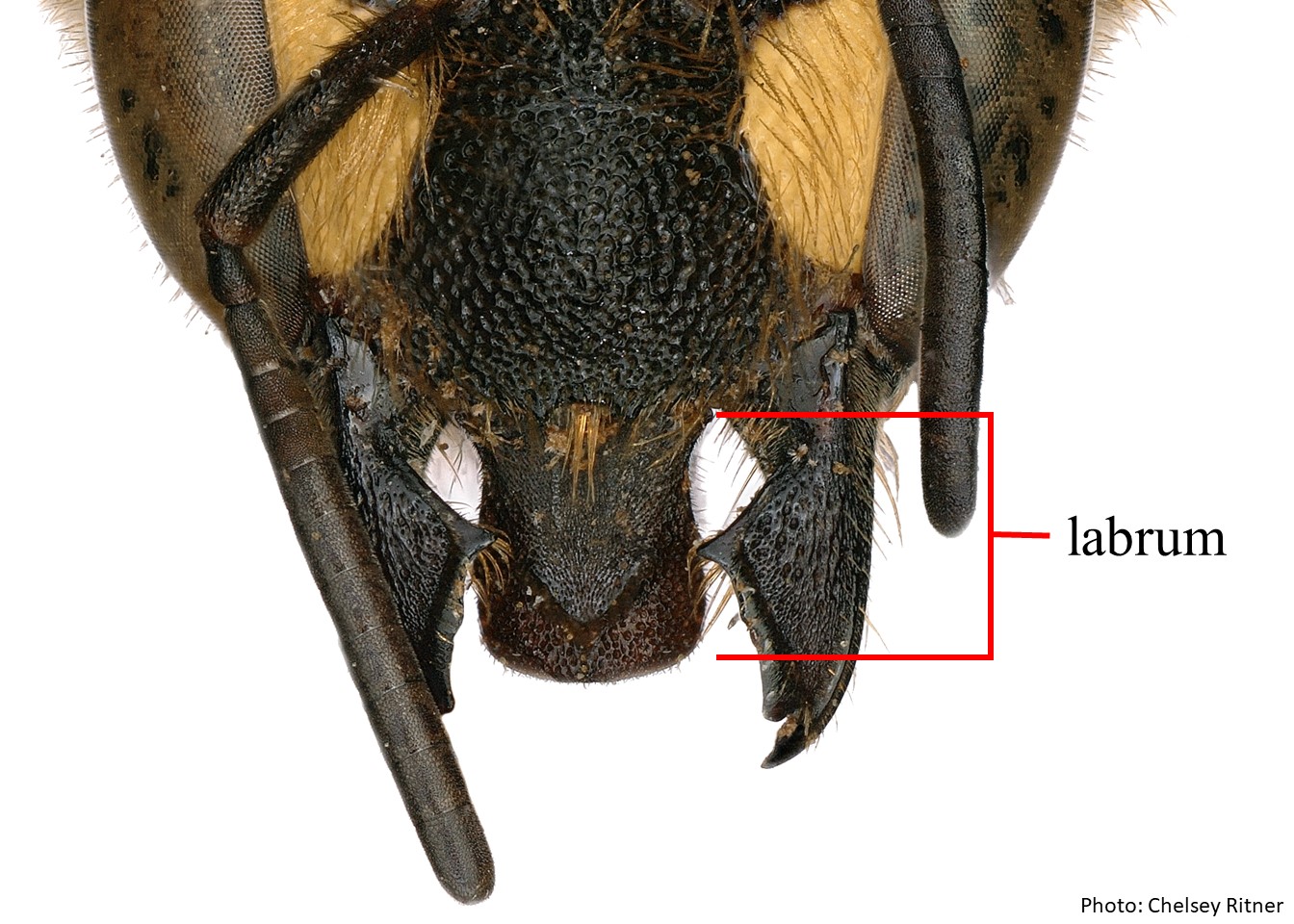Family: Megachilidae
Subfamily: Megachilinae
Tribe: Megachilini
Genus: Cremnomegachile Gonzalez & Engel, 2019
Subgenus: none
Common name: none
Cremnomegachile are elongate bees with shiny black integumentintegument:
a tough, protective outer layer
, aside from their brownish legs, mandibles, and antennae (Benoist 1962Benoist 1962:
Benoist, R. 1962. Nouvelles espegrave;ces d#39;Apides malgaches [Hym.]. Bulletin of the Entomological Society of France 67(9): 214-223.). They have primarily white hair on their body and apicalapical:
near or at the apex or end of any structure
bands of hair on the tergaterga:
the segments on the top side of the abdomen, often abbreviated when referring to a specific segment to T1, T2, T3, T4, T5, T6, or T7 (Benoist 1962Benoist 1962:
(Benoist 1962Benoist 1962:
Benoist, R. 1962. Nouvelles espegrave;ces d#39;Apides malgaches [Hym.]. Bulletin of the Entomological Society of France 67(9): 214-223.). Their body length ranges from 8.5–12 mm (Benoist 1962Benoist 1962:
Benoist, R. 1962. Nouvelles espegrave;ces d#39;Apides malgaches [Hym.]. Bulletin of the Entomological Society of France 67(9): 214-223.). The subgenus gets its name from the Greek word “kremnos,” which means “overhanging wall,” referring to the projected anterioranterior:
toward the head or on the head side of a segment being described
face of the scutumscutum:
the large segment on top of the thorax located between the wings and behind the head
, and “chile,” which means “tooth” (Gonzalez et al. 2019Gonzalez et al. 2019:
Gonzalez, V.H., G.T. Gustafson, and M.S. Engel. 2019. Morphological phylogeny of Megachilini and the evolution of leaf-cutter behavior in bees (Hymenoptera: Megachilidae). Journal of Melittology (85): 1-123.).
(modified from Gonzalez et al. 2019Gonzalez et al. 2019:
Gonzalez, V.H., G.T. Gustafson, and M.S. Engel. 2019. Morphological phylogeny of Megachilini and the evolution of leaf-cutter behavior in bees (Hymenoptera: Megachilidae). Journal of Melittology (85): 1-123.)
 carinatecarinate:
carinatecarinate: long and triangular.
long and triangular. without apicalapical:
without apicalapical: apicalapical:
apicalapical: preapicalpreapical:
preapicalpreapical:Cremnomegachile is similar to Stenomegachile in their elongate, shiny mandibles, the long labrumlabrum:
part of the head abutting the clypeus, folds down in front of the mouthparts
 , and the toothed hypostomalhypostomal:
, and the toothed hypostomalhypostomal:
the notched region underneath the head and behind the mandible that holds the folded tongue
area of the female and the bilobed preapicalpreapical:
referring to a section of a bee that is physically found just before the outermost (or apical) end of the section or segment
carinacarina:
a clearly defined ridge or keel, not necessarily high or acute; usually appears on bees as simply a raised line
of the male. The projected anterioranterior:
toward the head or on the head side of a segment being described
part of the scutumscutum:
the large segment on top of the thorax located between the wings and behind the head
of Cremnomegachile can be used to separate the two genera. In addition, females can be differentiated by the shape of the labrumlabrum:
part of the head abutting the clypeus, folds down in front of the mouthparts
 , which is triangular in Cremnomegachile and parallel-sided in Stenomegachile. Males also differ from each other in the number of mandibularmandibular:
, which is triangular in Cremnomegachile and parallel-sided in Stenomegachile. Males also differ from each other in the number of mandibularmandibular:
near the mandible
teeth, three in Cremnomegachile and four in Stenomegachile.
Floral associations are unknown.
Nesting behavior is unknown.
Cremnomegachile includes one species, Cremnomegachile dolichosoma (Gonzalez et al. 2019Gonzalez et al. 2019:
Gonzalez, V.H., G.T. Gustafson, and M.S. Engel. 2019. Morphological phylogeny of Megachilini and the evolution of leaf-cutter behavior in bees (Hymenoptera: Megachilidae). Journal of Melittology (85): 1-123.).
There are no known invasives.
Cremnomegachile is only known to occur in Madagascar (Pauly et al. 2001Pauly et al. 2001:
Pauly A., Brooks R.W., Nilsson L.A., Apesenko Y., Eardley C.D., Terzo M., Griswold T., Schwarz M., Munzinger J., and Y. Barbier. 2001. Hymenoptera Apoidea de Madagascar et des Iles Voisines. Annalen Zoologische Wetenschappen amp; Annales Sciences Zoologiques 286: 1ndash;406.).

Distribution map generated by Discover Life -- click on map for details, credits, and terms of use.
Benoist, R. 1962. Nouvelles espèces d'Apides malgaches [Hym.]. Bulletin of the Entomological Society of France 67(9): 214-223.
Gonzalez, V.H., G.T. Gustafson, and M.S. Engel. 2019. Morphological phylogeny of Megachilini and the evolution of leaf-cutter behavior in bees (Hymenoptera: Megachilidae). Journal of Melittology 85: 1-123.
Pauly A., R.W. Brooks, L.A. Nilsson, Y. Apesenko, C.D. Eardley, M. Terzo, T. Griswold, M. Schwarz, J. Munzinger, and Y. Barbier. 2001. Hymenoptera Apoidea de Madagascar et des Iles Voisines. Annalen Zoologische Wetenschappen & Annales Sciences Zoologiques 286: 1-406.i.